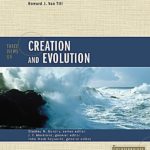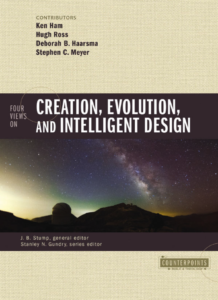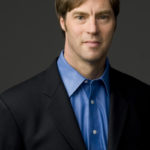May
13
“[The goal of the book] was to give a snapshot of the state of the conversation about origins among evangelical Christians in America…. I think readers will see fair and accurate representations of the four positions.” — J.B. Stump, general editor of Four Views on Creation, Evolution, and Intelligent Design and Senior Editor at BioLogos
This book is an answer to prayer. (Though, to be honest, I can’t remember ever articulating it as such.)
Sometime around 2000, one of the first books I read on the “origins debate” was Three Views on Creation and Evolution (1999), ed. J.P. Moreland & John Mark Reynolds. Part of Zondervan’s “Counterpoints” series, it included contributions by Paul Nelson & John Mark Reynolds (Young Earth Creationism), Robert C. Newman (Old Earth (Progressive) Creationism), and Howard J. Van Till (Theistic Evolution). The book wasn’t perfect, of course, as all such “Counterpoints” volumes have their strengths and weaknesses. But, I found it very helpful in comparing and contrasting the three primary “origins” positions held by professing Christians, and there was a lot of good information presented by the primary essayists and other contributors. (Oddly enough, rather than the primary contributors responding to one another, responses to their essays were done by Moreland, Walter L. Bradley, John Jefferson Davis, and Vern S. Poythress.) I still recommend the book to this day.
However, one thing that bothered me about the book was that the contributors, knowledgeable as they were, did not represent the majority thinking on their respective “sides” of the debate. Nelson, for example, was (and is) a philosopher specializing in biology and the history of science and a member of the Intelligent Design Movement, while Reynolds was a philosophy professor and founder/director of Biola’s Torrey Honors Institute.* Newman, Director of the Interdisciplinary Biblical Research Institute (IBRI), held to a minority position called the “Modified Intermittent Day” View. Van Till was a physics professor with his own somewhat idiosyncratic “Fully Gifted Creation” theory and who was already sliding into unorthodox Process Theology.
The writers had all been involved in the science/faith “discussion” for years. They were respected in their fields and had written books and articles. They certainly each represented a particular niche within their assigned section of the origins spectrum, and they did so admirably. But, I was still a bit frustrated. What I really would have preferred to read were essays by the most prominent voices in the creation/evolution debates at the time, *leaders* of apologetics organizations if possible, who were also more typical in their positions. For example, John Morris, Kent Hovind, or Duane Gish for the YEC view; Hugh Ross for the OEC view; maybe Richard Bube or Conrad Hyers for TE (since there was no major TE organization at the time). Contributions by such as these would have been much more representative and, thus, more “relevant” and helpful.
And, now, nearly 20 years later, I got my wish!
With the 2017 publication of Zondervan’s Four Views on Creation, Evolution, and Intelligent Design, ed. J.B. Stump, we have a “sequel” or replacement volume that does indeed have contributions from principal figures for each of the three main positions (who also lead their own organizations), plus one representing the Intelligent Design Movement. They are all eminently qualified, of course, and were the editor’s first choices. This time around, Ken Ham (founder and President/CEO of Answers in Genesis) represents the case for YEC; Hugh Ross (founder and President of Reasons to Believe) is the OEC proponent; Deborah B. Haarsma (President of BioLogos) advocates for Evolutionary Creation (aka TE); and Stephen C. Meyer (Senior Fellow of the Discovery Institute) presents the ID position.
Count me as one happy camper!
The format is that each contributor gets roughly 30 pages to makes the case for his/her view, followed by 5-6 page responses from each of the others, to which the case-maker then gets a 3-page rejoinder. Editor J.B. Stump bookends with an Introduction and a Conclusion. I will note that everyone is respectful, if presenting hard challenges to one another, and even Ham’s rhetoric is slightly muted from his typical style. (However, Stump does reveal that Ham stubbornly insisted on a slightly longer initial essay, justifying it due to his being the only one defending YEC and “the authority of Scripture vs. the authority of the scientific majority.”)
Each contributor does a fine overall job of presenting his/her respective position in the allotted space, and the responses and rejoinders help to challenge and clarify certain statements. There was a set of questions that the contributors were to keep in mind while writing. They were:
o What is your position on origins — understood broadly to include the physical universe, life, and human beings in particular?
o What do you take to be the most persuasive arguments in defense of your position? What are the biggest challenges for your view?
o How do you demarcate, correlate, and use evidence about origins from current science and from divine revelation?
o What hinges on having the correct view of origins?
Beyond that, they don’t seem to follow a common, point-by-point outline, so (as with any “X Views” book I’ve seen) not everything is covered in equal amounts (or even at all) by each contributor. The volume is better than some, though, and certainly the main points (e.g., Creation Days, Flood, biological diversity) are addressed. The only thing that kind of bugged me was that I really would have liked certain topics to be delved into more deeply, once the positions had been stated. We rarely get to hear/see this, and such is the downside of “debate” volumes like this one. This is one of the reasons I am looking forward to getting and reading the Old Earth or Evolutionary Creation? book that RTB and BioLogos recently put out, so I can see RTB and BioLogos address some of these topics in further detail.
It’s hard to truly review the rest of the Four Views book, since doing so would inevitably involve critiquing each of the positions. But, that’s not really what I want to do here. Those of you who have read any of my other posts on creation/evolution/ID issues know that I hold to Dr. Ross’s Day-Age interpretation within the OEC part of the spectrum, though I am also greatly appreciative of the contributions of the ID Movement. So, that type of review would obviously involve a *lot* of agreement with Ross and Meyer and a *lot* of pointing out where I think Ham and Haarsma are guilty of eisegesis, overstatements, misrepresentation, bad theology, blinding presuppositions, etc. But, I don’t want to go there….
What I will do, however, is give a brief quote by each of the four contributors that I found representative, insightful, or otherwise helpful to the overall discussion. I’ll even throw in one by editor Stump that I liked.
Ken Ham: “For young-earth creationists that apologetic task begins with Scripture, for it is the inspired, inerrant Word of God. God teaches us to build our thinking on the solid rock of His Word (Matt 7:24-27). We are not to turn from it to the right or the left (Josh 1:8-9). We are to avoid being taken captive by the traditions and philosophies and speculations of men by clinging to the Word of Christ (2 Cor 10:3-4; Col 2:8). God’s creation speaks to us non-verbally about His existence and attributes (Rom 1:18-20; Pss 19:1; 97:6). But Scripture speaks to us verbally and truthfully about so much more. And as we shall see, creation is cursed, whereas Scripture (the written Word) is not. Without the biblical revelation about the cosmos-impacting fall of man, the creation gives a confusing message about the Creator. Therefore, we start our thinking about origins (as in all other areas) with Scripture, God’s inerrant, holy Word.” (p.19)
Hugh Ross: “Providing a testable, biblical creation model answers the charge that creation and intentional design remain outside science’s purview because they’re not falsifiable. Also, such a model, unlike most theistic-evolution and evolutionary-creation models, offers clear scientific distinctions from deism, providing multiple scientific evidence — post cosmic creation event — for God’s direct involvement in nature. The day-age perspective enables the development of a biblical creation model that is verifiable or falsifiable by achievable scientific discoveries. Such a model provides a measurably more comprehensive and harmonious explanation of nature’s record than nontheistic, deistic, and nonbiblical theistic models. It also potentially points toward or predicts future scientific discoveries. [Such a model] opens doors for discussions of the gospel that otherwise remain shut. It marshals scientific evidence showing that the God of the Bible is our intelligent, intentional designer and that he has intervened repeatedly throughout natural history on our behalf to make himself and his redemptive purpose known.” (p.78)
Deborah B. Haarsma: “Both nature and Scripture are subject to human interpretation, in the form of the disciplines of science and biblical scholarship. It is crucial that we do not confuse our human interpretations with God’s actual revelation, since we can be in error in our understanding. Conflicts appear only when our interpretation of one or both books is in error. Such conflicts rightly prompt us to reconsider our views: Are there other faithful ways to interpret the biblical text? Are there other valid ways to understand the scientific evidence? Each discipline can provide an important corrective to the other, protecting it from overreaching and prompting it to reevaluate. But one discipline should not drive the conclusions of the other. Science should not dictate the best biblical interpretation, and biblical studies should not force the conclusions of science.” (p.127)
Stephen C. Meyer: “All historical scientists must compare the causal adequacy of competing hypotheses in order to make a judgment as to which hypothesis is best. We would not say, for example, that an archeologist had committed a ‘scribe of the gaps’ fallacy simply because — after rejecting the hypothesis that an ancient hieroglyphic inscription was caused by a sand storm — he went on to conclude that the inscription had been produced by a human scribe. Instead, we recognize that the archeologist has made an inference based upon the experience-based knowledge that information-rich inscriptions invariably arise from intelligent causes, not solely upon his judgment that there are no suitably efficacious natural causes that could explain the inscription.” (p.205)
J.B. Stump: “[R]egularly subject your views to critique. Don’t just read the people you agree with, but make an attempt to really understand why others are equally persuaded of different views. Studies show we are hard-wired to see and accept reasons that support what we already believe and to quickly dismiss evidence that challenges our own positions. But if we’re serious about pursuing the truth in these matters, it is important. And if we ourselves are in the position where others look to us as experts, it is doubly important that we do this with integrity. I think this book makes a good contribution toward that goal. No matter what your perspective on origins, you should be able to find points and questions here that challenge you to examine again what you believe on these matters.” (p.234)
So,… should you buy/read Four Views on Creation, Evolution, and Intelligent Design? Absolutely. Whether you are relatively new to the ‘origins’ debates or an old hand, as Stump suggests, you are sure to find something worthwhile — a novel analogy, better summary, new challenge, explanation you hadn’t heard before, etc. –, particularly if you are unfamiliar with any of the views presented. Plus, it’s almost always helpful to see (or hear) representatives of different positions go head-to-head, especially in a somewhat structured context and where civil discourse is enforced. Zondervan’s ‘Counterpoints’ series is great for just that.
P.S. If you haven’t already seen them, you might want to check out these posts for more information:
“Primer on Origins Views for Christians (Part 1 of 3)” (and the rest of the series, of course)
“So, You Want to Learn about Old-Earth Creationism…”
* Nelson and Reynolds conceded that, “[a]t the moment, [OEC] would seem the more rational position to adopt.” Earlier in their essay, they argued that the “two very good reasons to maintain a young earth position” are that “recent creationism is intellectually interesting” and “a coherent recent creationism would be a great boon to religious belief.” I found (and still find) such justification to be wholly inadequate, and I know Ken Ham thinks there is a lot more at stake and in support of a YEC view.






















